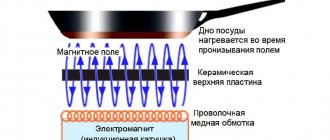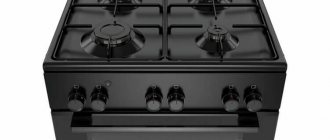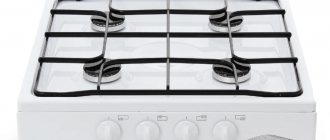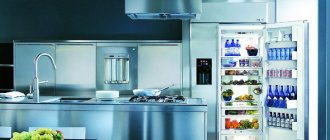Basic criteria for comparing cooking equipment
Before deciding what to choose: a hob or a stove for your kitchen, let’s outline the main criteria for the upcoming choice. Regardless of the design of the room and its size, the following factors become determining:
- design capabilities and appearance of each unit;
- dimensions and weight of the unit;
- price;
- installation conditions and technology;
- functionality and technical capabilities;
- power consumption.
Note! Only an integrated approach to purchasing kitchen appliances, taking into account all requirements and operating conditions, will allow you to make the right choice between the two types under consideration.
Surface Features
All users know the individual features of gas and electric stoves from operating experience, so let’s not waste time, but pay attention to the panels.
Familiar appearance
The best representatives of gas surfaces have burners with two or even three rows of perforations, which significantly increases the heating time of the dishes. The kit necessarily includes an economy nozzle, sometimes equipped with a device that hides open fire for uniform heating of the bottom of the cookware.
The gas hob is made of glass ceramics, which guarantees a rather stylish appearance; according to users, it is very convenient to cook on such splendor, and cleaning is not difficult. The burners are protected by durable original grates made of cast iron or steel coated with heat-resistant enamel.
New technologies
Glass ceramics have firmly entered the everyday life of Russian users; it has a number of advantages over enameled surfaces, but is afraid of mechanical stress: it is easily scratched even by sugar or salt crystals, not to mention pinpoint impacts that can split it. As for a simple electric stove, it only heats up in the area where the burners are installed, while an induction panel has no surface heating at all.
Such hobs are already being replaced by mirror glass panels, which have similar advantages, but cost much less, decorate the kitchen interior many times better and are not afraid of mechanical impact from falling small objects. A lot can be said about the advantages of conventional gas and glass-ceramic built-in panels; they perform well in operation and have individual advantages, but the main thing is safety. For new surfaces it is much higher than for gas stoves.
Features of the appearance of a gas stove and hob
Every year manufacturers show more and more imagination. The color range of the equipment is amazing, and the specific shape satisfies the needs of any room shape. Considering individual models - hob and stove, we note the following points:
- Induction often looks organic and advantageous. One of the nuances is that you will have to buy an oven in the appropriate style. And this problem is not as easy to solve as it might seem at first glance. In any case, in terms of external indicators, the stove will fit perfectly into the interior and will look fresh and fashionable.
- An oven is originally a single piece of equipment that has many functions for preparing all types of food. In this case, it will be enough to simply decide on the desired variation, based on the overall stylistic decision of the kitchen.
Which is better to choose?
It is quite difficult to give a definite answer. It all depends on what goals and objectives a person sets for himself. The choice in this case depends on many parameters:
- dimensions and layout of the kitchen;
- cost of the device;
- frequency of use;
- the importance of having an oven;
- preferred power type: gas, electricity or induction;
- overall dimensions and weight of the device;
- ease of installation;
- other factors.
Let's look at how a hob differs from a stove, and what advantages and disadvantages each of these units has.
- 5 best Kitfort cookers according to customer reviews
- 5 best ENDEVER kitchen stoves according to customer reviews
- 8 best BEKO cookers according to customer reviews
- 9 best kitchen stoves Dream according to customer reviews
- 9 best Flama cookers according to customer reviews
- 10 best Hansa cookers according to customer reviews
Dimensions and weight of the food preparation unit
If we consider dimensions and weight as a criterion for choosing equipment, then in this case the question is “which is better?” solved much faster.
- An ordinary stove, even a new-fangled, improved model, is bulky and heavy, so you need to take care in advance about the future location of its installation and the configuration of kitchen furniture nearby. If you plan to cook often and a lot, especially when cooking for the winter, then you should remember that the stove will withstand any weight load without restrictions.
- The built-in cooking surface takes up little vertical space, is very compact, and allows for the most useful and efficient use of the space underneath. Of the minuses, we note that the maximum load on one burner is 5 kilograms, and in general for the entire area no more than 15 kilograms.
Important! Remember that if you are going to purchase an oven for built-in appliances, then compactness and space saving are not relevant in this case.
Let's summarize
The principle of placement of the stove in no way affects the quality of its work, therefore both conventional and built-in models have an equal right to be approved.
Buying a “built-in” will be especially beneficial for those whose kitchen does not boast a large area, but in this case you will have to be prepared not only for big expenses, but also for additional hassle: meticulous planning of the furniture, professional installation, and in case of moving, even very tedious dismantling.
On the other hand, the situation is not at all as sad as it might seem - the financial investment will be repaid by the ease of use, as well as the stylish and compact design of the electric assistant. A solid countertop will prevent the accumulation of dirt and debris, and with the oven positioned correctly, the housewife will never have to “bow” to a low door again.
Installation conditions and technology
When choosing what is easier and faster to install: an electric oven, hob or gas stove, you should consider the following points:
- An electric oven can be easily installed in any corner of the apartment without restrictions. Electric operation requires only an outlet and no additional expenses for the services of professional installers.
- To install a gas model, a clear calculation of the dimensions of the unit and the installation location and dimensions of other furniture is required. Connection and commissioning are carried out exclusively by special service employees.
Important! Combined devices require installation by professionals, since gas is the priority hazard.
- The induction cooker must be installed by craftsmen with the appropriate qualifications and profile, since they are built into kitchen furniture. In addition, it is necessary to carefully prepare the furniture itself: mark and make precise cuts so that there are no large cracks or gaps left after installing the equipment.
Stove in a special cabinet
Anyone who prefers to have traditional appliances in the kitchen may like its built-in version. Additional costs may apply for installation in a designated cabinet. But they are usually compensated for when purchasing, since initially built-in equipment does not have its own housing and costs less.
The stove consists of two built-in parts - a hob and an oven. There are models in which both parts are dependent on each other, connected by wires and have a single control mechanism. They are traditionally installed one above the other.
The advantage of a built-in stove is that it fits better into the interior, organically combining with kitchen furniture.
Functionality and technical indicators
It is difficult to accurately answer the question of which stove is better, an electric one (not a hob) or a gas one. In this case, the comparison depends on each person's personal priorities.
- Ease of use and functionality are often determined by the type of energy consumption. Gas ones allow you to cook dishes as quickly and naturally as possible, and also have the ability to accurately set the flame in the burner. Electric models are somewhat inferior in terms of cooking speed and temperature accuracy, but they are many times safer.
- The speed of heating and cooling of the burners, and therefore the power of the built-in panel, depends on the principle of operation and the material of execution. A limited number of dishes in terms of weight, volume and type are often prepared on such a surface. Of all the options, built-in surfaces are called the safest, since in the absence of dishes the oven does not heat up. In addition, modern models have diverse functions - timers, auto shut-off, saving energy consumption.
To quickly decide, it is important to remember the following nuances:
- If you have a choice: a stove or a built-in panel, but you want to buy an electric oven without an oven, then in this case, take the hob type.
- If you are choosing between a gas or built-in surface, if you have a family and a love of cooking, then it is better to give the palm to the classics of the genre.
The nuances of an independent oven
Many users are still not aware of the difference between an oven and an ordinary oven installed in a standard stove. The main differences between electric and gas ovens are known to everyone: the former are much more powerful, and their baked goods turn out more appetizing, with a fragrant golden brown crust. They are not very different in size: the same standard is 600x600 mm, but models are available with a width in the range of 700-900 mm, however, their cost is high.
They are installed independently, i.e. it is not necessary to build them under the countertop. Many users place them separately and above the table for convenient use, and bright lighting helps to monitor the cooking process. An autonomous cabinet is available in gas or electric, but the former has a smaller range, because it is in little demand: making a separate connection is unprofitable for many buyers.
The electric option has a number of advantages:
- location at eye level;
- ease of connection;
- delay start timer;
- several modes;
- Some models have a microwave mode - you can save money and space in the kitchen by purchasing two in one.
The disadvantages are similar to all the negative qualities that are inherent in electrical equipment.
This is interesting: Rating of the best TVs for the kitchen in 2021 (TOP 9)
Generalized advantages and disadvantages of induction
Based on all of the above, let’s summarize.
Advantages of this type
- Heating occurs faster than with gas, for example, 5 liters of water boils on induction in 4 minutes, and on gas in 12;
- 4 times more economical than heating element;
- during cooking, you can lay a towel under the frying pan, or simmer dishes without a lid;
- dishes and furniture are not smoked;
- many programs and timers;
- temperature regulation without accidentally extinguishing the fire.
Disadvantages of the induction model
- relatively fragile surface;
- special utensils or adapters are required;
- Aluminum and copper utensils are not suitable;
- for certain models you will have to derive a separate phase.
How to choose the best gas panel for recessing
Gas hobs are available with different numbers of burners. On sale there are options with burners from 1 to 6 pieces or more.
Models with 3-4 burners are most popular in everyday life, while models with 1-2 burners are most popular in dachas and small kitchens. Five to six burners are required only in very large families and catering establishments.
The cost and durability of such panels is affected by the surface material:
1. Enameled metal - a budget option. It is easy to clean, but during use it may become chipped.
2. Stainless steel is a more durable and not too expensive material. It requires care because it is constantly covered with stains and “incurable” scratches.
3. Tempered glass is a more expensive and easier to clean coating. However, water spots and stains will appear on it.
4. Glass ceramics is a reliable impact-resistant coating that has the highest cost and requires specific care.
The grates above the burners are made of cast iron or steel. The first material is more durable and resistant to deformation, but due to its porous structure it is difficult to care for. Steel is easier to clean from contaminants and costs less, but it wears out faster.
When installing a gas hob, you should ensure that you have a powerful kitchen hood. Otherwise, paraffin soot will quickly cover the ceiling and furniture next to the stove.
When choosing a panel, you should also pay attention to additional options. The more of them, the more functional, but also more expensive your equipment
Gas equipment usually has few such additions, but they are all useful and sometimes simply necessary.
Such important functions include: gas control, auto-ignition, burner with triple or double crown. Sometimes this can be a barbecue grill or other types of burners (usually electric) - and then we are talking about combined panels.
Advantages and disadvantages of gas stoves
Let us summarize all the information collected about gas stoves:
Advantages of gas
- there are no problems with purchasing specialized utensils;
- no dependence on power outages;
- often the price of gas is lower than that of electricity;
- There are no problems with wiring.
Disadvantages of this type
- increased risk of explosion;
- the need to legitimize any movement of the unit;
- cleaning the gas model is more labor-intensive;
- Gas smokes when burned, so an exhaust hood is needed.
Which option to choose depends on personal preferences and the capabilities of your wallet. Weigh the pros and cons, and you will definitely make the right choice.
Which is better: induction or electric stove, pros and cons of products
To understand the question of how an induction cooker differs from an electric one, you must begin by studying the operating principle of each device. The electric device immediately heats the burner to the required temperature. The heat is then transferred to the utensils placed in the work area. Heat is generated as a result of the passage of electric current through a conductor.
The electric stove first heats itself and only then transfers the heat to the cookware
The latter is a resistive heating element, which is characterized by a high resistivity value. The conductor is represented by a spiral, which can be located openly or hidden under the burner.
Among the distinctive advantages of an electric stove are the following:
- silent operation of the device;
- the ability to use any utensils;
- reasonable cost;
- the burners heat up for a long time and cool down slowly, so you can leave the finished dish on the surface to “cook”;
- a wide range of color and design variations, which allows you to choose a model to suit any interior style of the room;
- the surface does not require special care and can be easily and simply cleaned using ordinary detergent.
The disadvantages of the stove include:
- significant energy costs;
- the panel has a limit on the weight it can withstand;
- a high degree of fire hazard increases the likelihood of traumatic burns.
High power consumption is one of the disadvantages of the electrical panel
Selection principles
When determining the type of stove for your home, you should not rely only on personal preferences; it is important to take into account a huge number of criteria. The most significant are:
- safety;
- cooking speed;
- functionality;
- price;
- oven capabilities;
- external attractiveness.
It is worth noting that regarding appearance there is no specific answer as to which stove, electric or gas, will be more attractive. The manufacturer today tries to take into account all the user’s wishes, therefore both models are presented in a wide range, among which it is not difficult to choose an option to suit your taste
Also, some people buy what is cheaper and will not pay too much attention to appearance or functionality. But for others it is more important to buy the device that will be more economical to use











